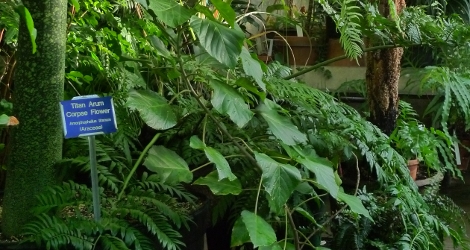Accession Data:
Neobeckia aquatica (Eaton) Greene
- Common Name:
- Family: Brassicaceae Burnett
- Country of Origin: Eastern North America
- Description: Neobeckia has also been described under a number of synonyms including Armoracia lacustris, Armoracia aquatica, and a number of others in Nasturtium and Rorippa.
Submersed or emergent perennial; stems weak to erect, arising from slender rootstocks or dense rosettes of leaves, usually simple but flowering stems occasionally branched, 4-8 dm long; submersed leaves dissected into numerous capillary divisions; upper cauline leaves oblong to lanceolate, entire or dentate, cuneate at base, lower emergent or partially submersed cauline leaves often transitional in form, entire, serrate, pinnatifid, or dissected; inflorescences elongated on widely spreading branches; sepals yellowish-white, erect; petals white; fruiting pedicels widely spreading, slightly ascending to slightly deflexed, usually straight, 1-1.5 cm long; siliques ellipsoid, 4-6 mm long, divergent on the same angle as the pedicels, shortly stipitate; septa perforate, residual as narrow strips on the inner margins of the replums; ovules numerous; styles 2-3 mm long with broad persistent slightly bilobed stigmas.
Flowers April - August. Quebec to Wisconsin, south to Florida and Texas. Rivers, streams, springs, ditches, sloughs, swamps and lakes. 2n = 24.
This species is not known to reproduce sexually, and despite occasional seed production, seed fertility has not yet been demonstrated. Sterility is attributed to triploidy which has been documented in Wisconsin, Michigan, Ohio and Vermont populations. Reproduction is exclusivley by vegetative means and nearly any fragment of a plant is capable of regenerating complete new individuals. Leaves detcach from plants at the slightest disturbance and account for much of the local spread of the species.
Accession Data:
- Accession # 199600002
- Source: D. Les
- Provenance:
Collected by Don Les - August 29,1993 in Shoreham, VT (Les 508; CONN). Bridge at dirt road that crosses Fair River (SE of covered bridge); this is the east fork; plants all fragmented.
- Accession Date: 03-26-1996
- Bench: 2309 - Temperate Carnivores
- Currently: active - healthy
- Qty: 2 confirmed on 07-16-2024
Classification:
- Division: Magnoliophyta
- Class: Magnoliopsida
- SubClass: eurosid II
- Order: Brassicales
- SubOrder:
- Family: Brassicaceae
- SubFamily:
- Tribe: Cardamineae
- SubTribe:
Flowering Data:
This accession has been observed in bloom on:| Year | Jan | Feb | Mar | Apr | May | Jun | Jul | Aug | Sep | Oct | Nov | Dec | ||||||||||||||||||||||||||||||||||||||||
|---|---|---|---|---|---|---|---|---|---|---|---|---|---|---|---|---|---|---|---|---|---|---|---|---|---|---|---|---|---|---|---|---|---|---|---|---|---|---|---|---|---|---|---|---|---|---|---|---|---|---|---|---|
| 2024 | ||||||||||||||||||||||||||||||||||||||||||||||||||||
| 2023 | ||||||||||||||||||||||||||||||||||||||||||||||||||||
References (internal):
References (external):
data regenerated on Tue, 16 Jul 2024 14:21:01 -0400 [bcm v4.0]
Images:

Additional images for this accession:
Click on thumbnails to enlargeCurrent Accessions in the Brassicaceae
Subfamily
Tribe Anastaticeae
Subfamily
Tribe Cardamineae
Subfamily
Tribe Iberideae
Subfamily
Tribe Thlaspideae
W/C = Wild Collected
 = indicates flowering in past 14 days
= indicates flowering in past 14 days
 = images available for this accession
= images available for this accession
 = map available for this accession
= map available for this accession
 = accession added within past 90 days
= accession added within past 90 days